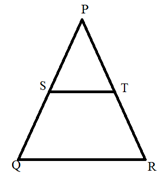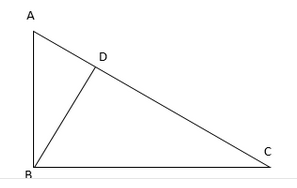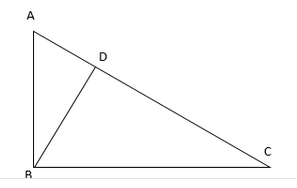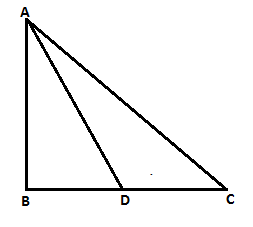10th Grade > Mathematics
TRIANGLES MCQs
:
C
In △CDB,
BC2=CD2+BD2 [Pythagoras theorem]
BC2=CD2+(DA+AB)2
BC2=CD2+DA2+AB2+(2×DA×AB) ...(i)
In △ADC,
CD2+DA2=AC2 ...(ii) [Pythagoras Theorem]
Here, ∠CAB=120∘ (given)
⇒∠CAD=60∘ (since ∠CAD and ∠CAB form a linear pair of angles)
Also, cos60∘=ADAC
AC=2AD ...(iii)
Substituting the values from (ii) & (iii) in (i) we get,
BC2=AC2+AB2+(AC×AB)
a2=b2+c2+bc
Alternatively,
Since ∠A is an obtuse angle in △ABC so,
BC2=AB2+AC2+2AB.AD =AB2+AC2+2×AB×12×AC [∵AD=ACcos60∘=12AC] =AB2+AC2+AB×AC
⇒a2=b2+c2+bc
:
In △ABC,
DE ∥ BC (Given)
Therefore, ADAB = AEAC [By Basic Proportionality Theorem]
Comparing the above with ADAB = AEx
x = AC
:
D
∠S=180o−(∠A+∠C)
The angles of the traingle are known. With the given measurement of the angles, we can draw infinite number of traingles (Similar triangles).
:
It is given that
PSSQ = PTTR
So, ST||QR [By converse of Basic Proportionality Theorem]
∴, ∠PST=∠PQR (Corresponding Angles)
Also, it is given that
∠PST = ∠PRQ
So,∠PRQ = ∠PQR
Therefore, PQ = PR (Sides opposite the equal angles)
i.e., ΔPQR is an isosceles triangle.
:
B
Let the triangles be △ABC and △DEF
Then AB=3 units and DE=4 units.
Each angle of both △ABC and △DEF is 60∘.
△ABE∼△ ACF
( AAA similarity)
So,
ar(ABC)ar(DEF)=BC2EF2=3242=916
:
C
Consider the above figure:
AD is the part of the ladder in the first case and AC is the ladder in the second case
AB = BD = 10 √7m [given]
2AD = AC [since AD is the half of the ladder AC]
∴ By Pythagoras Theorem in △ABD,
AD2 = AB2 + BD2
⇒ AD2 = (10√7)2 +(10√7)2
= 2 (10√7)2
⇒AD=10√7√2
Since AD is half of the ladder, the complete length of the ladder
AC = 2AD = 20 √2√7
Now,
In ΔABC,
AC2 = AB2 + BC2
⇒ BC2=AC2−AB2
=(20√7√2)2 - (10√7)2
=(10√7)2[(2√2)2−1]
= (10√7)2×7
∴BC=10√7×√7=70 m
:
A
If two triangles are similar, then the ratio of the corresponding sides are equal.
Hence,
the ratio of heights = the ratio of sides = 1 : 3.






















